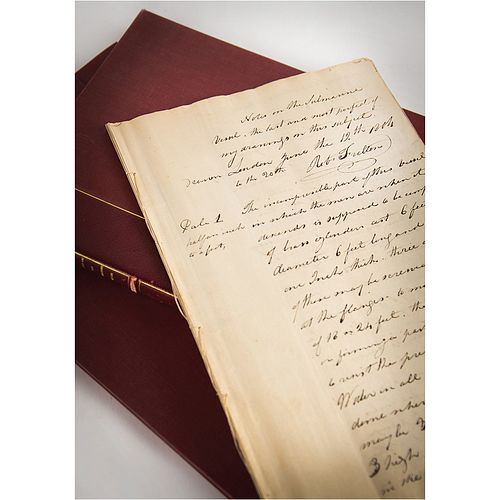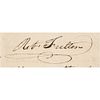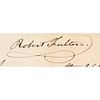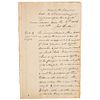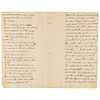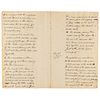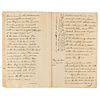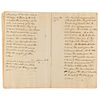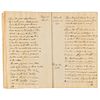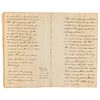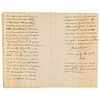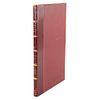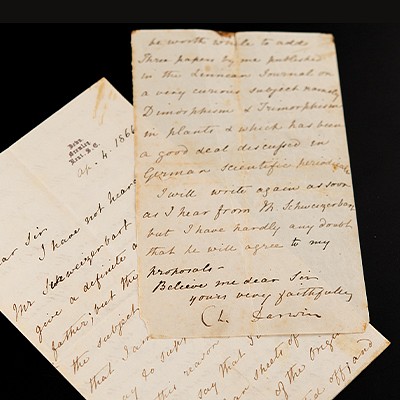Robert Fulton Autograph Manuscript Signed on Submarine Construction and Warfare
Two ways to bid:
- Leave a max absentee bid and the platform will bid on your behalf up to your maximum bid during the live auction.
- Bid live during the auction and your bids will be submitted real-time to the auctioneer.
Bid Increments
| Price | Bid Increment |
|---|---|
| $0 | $5 |
| $50 | $10 |
| $200 | $25 |
| $500 | $50 |
About Auction
Apr 17, 2024
With nearly 900 lots up for auction, RR Auction's April Fine Autographs and Artifacts sale focuses on historic material from the 19th and 20th centuries. Among the highlights are a rare check signed by Abraham Lincoln; a significant Leon Trotsky publishing contract; important scientific letters by Albert Einstein and Charles Darwin; several remarkable naval manuscripts; and a historic letter by Martin Luther King, Jr. on the integration of higher education. RR Auction support@rrauction.com
- Lot Description
American inventor, engineer, and entrepreneur (1765-1815) best known for designing the first commercially successful steamboat. Important autograph manuscript signed twice, "Robt. Fulton" and "Robert Fulton," fifteen pages on eight leaves, 8 x 12.5, June-July 1804. Fulton pens a summary of his submarine experiments, headed: "Notes on the Submarine Vessel, the last and and most perfect of my drawings on this subject, drawn London, June the 12th 1804 to the 20th." The text of this document is designed to accompany seven plates (not present), and it is a direct forerunner of Fulton's later manuscript discussion of his work, 'On Submarine Navigation,' completed in August 1806; the descriptions of the plates in this manuscript are closely comparable to those in the 1806 manuscript, but by no means identical—Fulton's revisions reflect changes in nomenclature for devices described and findings from experiments conducted in the interim two-year period.
The text begins with a description of the submarine vessel, in part: "The incompressible part of this vessel in which the men are when it descends is supposed to be composed of brass cylinders cast 6 feet diameter 6 feet long and about one inch thick, three or more of those may be screwed together at the flanges—to make a length of 16 or 24 feet. The ends...part of a sphere to resist the pressure of the Water in all directions. The dome where the men enter may be 3 feet diameter and 3 high with a smaller dome in the lid through which to make observations when just rising above the surface of the water." He goes on to present a list of "different parts" of a submarine vessel, noting that "any mechanic can trace their movements and uses." Among the items listed are "the Bow anchor," "the plunging flyers," "the Bow cable," "a small safety pump to drive the water out of the ballancing chest," "a pipe and cock to let the water into the ballancing chest," "a movement to work the rudder while under water," "the crank of the stem flyers," and "a screw movement to hoist the stern flyers out of gear...and out of water when the vessel is under sail." The manuscript goes on to describe several of these parts with greater specificity.
Concluding the manuscript, Fulton writes: "These seven drawings with this discription will enable any able mechanician to construct and perform the experiments of a plunging Vessel—This vessel is not intended to be brought under a ship which is to be attacked. All that can be expected of a vessel of this kind is to hide herself if pursued or lie under the water during the day approaching the harbours or fleets in the night and there depositing her cargo of submarine bombs anchor them or have them to the tide or use them by any other means which time and practice may point out. This engine pursued to perfection will to a certainty totally annihilate the existing military marine system and give liberty to the seas and more permanent peace to nations. It is a great agent in promoting liberty and the friends of man by curing the madness of stupid politicians—it is worthy [of] the genius and utmost care of the United States, as it will guard that young and prosperous republic...I have taken precaution to secure it to my country least any accident should happen to me in my present enterprise to introduce a new mode of destroying fleets into effect which if successful will never stop till the ocean is swept clean and commerce enjoy her rights."
Fulton signs at the conclusion in full, "Robert Fulton, London, July the 26th 1804," adding: "A number of drawings and papers on this subject will be found among my possessions gone from France to America." In fine condition, with some slightly irregular light toning. Accompanied by a custom-made presentation folder and slipcase, lettered in gilt on the maroon morocco spine.
Fulton had arrived in London from France in the spring of 1804 to offer the British his services in developing submarine weapons, having recently designed the 'Nautilus' submarine in France under a grant from Napoleon Bonaparte. The English initially offered Fulton £800 to develop a second Nautilus for the Royal Navy; however, after their victory over Napoleon's fleet at the Battle of Trafalgar, the work was deemed unnecessary and progress came to a halt. Frustrated at being sidelined, Fulton made the decision to return to the United States in 1806, where he presented his ideas on submarines and naval warfare to the United States government, believing that the advent of submarine defenses would bring a "more permanent peace to nations." An important autograph manuscript offering a fascinating record of the evolution of Fulton's work in submarines.
Ex. Sotheby's, 1987. - Shipping Info
-
Bidder is liable for shipping and handling and providing accurate information as to shipping or delivery locations and arranging for such. RR Auction is unable to combine purchases from other auctions or affiliates into one package for shipping purposes. Lots won will be shipped in a commercially reasonable time after payment in good funds for the merchandise and the shipping fees are received or credit extended, except when third-party shipment occurs. Bidder agrees that service and handling charges related to shipping items which are not pre-paid may be charged to a credit card on file with RR Auction. Successful international Bidders shall provide written shipping instructions, including specified Customs declarations, to RR Auction for any lots to be delivered outside of the United States. NOTE: Declaration value shall be the item’(s) hammer price and RR Auction shall use the correct harmonized code for the lot. Domestic Bidders on lots designated for third-party shipment must designate the common carrier, accept risk of loss, and prepay shipping costs.
-
- Buyer's Premium



 EUR
EUR CAD
CAD AUD
AUD GBP
GBP MXN
MXN HKD
HKD CNY
CNY MYR
MYR SEK
SEK SGD
SGD CHF
CHF THB
THB